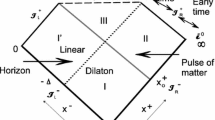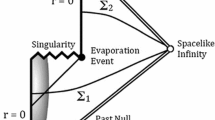Abstract
Classically, black holes admit maximal interior volumes that grow asymptotically linearly in time. We show that such volumes remain large when Hawking evaporation is taken into account. Even if a charged black hole approaches the extremal limit during this evolution, its volume continues to grow; although an exactly extremal black hole does not have a “large interior”. We clarify this point and discuss the implications of our results to the information loss and firewall paradoxes.
Similar content being viewed by others
Notes
See also sec. (6.3.12) in [5] in which it was pointed out that “there is no dearth of space inside (a black hole)”.
In 4-dimensions, the black hole horizon is 2-dimensional and one can think of a flat square torus as the product of two circles, \(T^2 = S^1 \times S^1\), each of which has period \(2\pi K\).
This volume expression is, curiously, also the same as that of 5-dimensional AdS toral black holes [7].
It is worth emphasizing that the lack of maximal “large volume” in the sense of Christodoulou and Rovelli, does not imply the absence of any volume behind the horizon. Taken at face value, the Penrose diagram for an extremal black hole clearly shows that there is still “normal” spacetime region inside (see, however, [14, 15]).
Excitations over the thermal spectrum are to be expected for many models of Hawking evaporation. However one should not expect a large deviation from a thermal spectrum, at least up to the Page time [22, 23]. For a pedagogical introduction to the Page time and quantum information theory in the context of black hole information loss, see [24].
If black hole evaporation is indeed unitary, it has been argued that the mass loss is not monotonic, due to the flux of negative energy that reached asymptotic infinity [25, 26]. However such influx of negative energy is strongly constrained by quantum energy inequalities [25] and therefore should not affect the overall evolution of black holes too much.
References
DiNunno, B.S., Matzner, R.A.: The volume inside a black hole. Gen. Relativ. Gravit. 42, 63 (2010). [ arXiv:0801.1734 [gr-qc]]
Christodoulou, M., Rovelli, C.: How big is a black hole? Phys. Rev. D 91, 064046 (2015). [ arXiv:1411.2854 [gr-qc]]
Reinhart, B.L.: Maximal foliations of extended Schwarzschild space. J. Math. Phys. 14, 719 (1973)
Estabrook, F., Wahlquist, H., Christensen, S., DeWitt, B., Smarr, L., Tsiang, E.: Maximally slicing a black hole. Phys. Rev. D 7, 2814 (1973)
Jacobson, T.: Introduction to quantum fields in curved spacetime and the Hawking effect.[ arXiv:gr-qc/0308048]
Bengtsson, I., Jakobsson, E.: Black holes: their large interiors. Mod. Phys. Lett. A30, 1550103 (2015)
Ong, Y.C.: Never judge a black hole by its area. JCAP. 2015(4), 003 (2015)
Wheeler, J.A.: Geometrodynamics and the issue of the final state. In: DeWitt, B.S., DeWitt, C.M. (eds.) Relativity, groups, and topology, pp. 315–520. Gordon and Breach, New York (1964)
Hsu, S.D.H., Reeb, D.: Black hole entropy, curved space and monsters. Phys. Lett. B 658, 244 (2008). [ arXiv:0706.3239 [hep-th]]
Ong, Y.C., Chen, P.: The fate of monsters in anti-de Sitter spacetime. J. High Energy Phys. 07, 147 (2013). [ arXiv:1304.3803 [hep-th]]
Hawking, S.: Breakdown of predictability in gravitational collapse. Phys. Rev. D 14, 2460 (1976)
Chen, P., Ong, Y.C., Yeom, D.-h.: Black hole remnants and the information loss paradox.[ arXiv:1412.8366 [gr-qc]]
Aharonov, Y., Casher, A., Nussinov, S.: The unitarity puzzle and Planck mass stable particles. Phys. Lett. B 191, 51 (1987)
Marolf, D.: The dangers of extremes. Gen. Relativ. Gravit. 42, 2337 (2010)
Garfinkle, D.: How extreme are extreme black holes? Class. Quant. Grav. 28, 175005 (2011). [ arXiv:1105.2574 [gr-qc]]
Almheiri, A., Marolf, D., Polchinski, J., Sully, J.: Black holes: complementarity or firewalls? J. High Energy Phys. 1302, 062 (2013). [ arXiv:1207.3123 [hep-th]]
Almheiri, A., Marolf, D., Polchinski, J., Stanford, D., Sully, J.: An apologia for firewalls. J. High Energy Phys. 1309, 018 (2013). [ arXiv:1304.6483 [hep-th]]
Braunstein, S.L., Pirandola, S., Życzkowski, K.: Better late than never: information retrieval from black holes. Phys. Rev. Lett. 110, 101301 (2013). [ arXiv:0907.1190 [quant-ph]]
Johnson, C.V.: D-Branes. Cambridge University Press, Cambridge (2003)
Vaidya, P.C.: The gravitational field of a radiating star. Proc. Indian Acad. Sci. Sect. A 33, 264 (1951)
Fabbri, A., Navarro-Salas, J.: Modeling Black Hole Evaporation. Imperial College Press and World Scientific Publishing Co., Pte. Ltd., London (2005)
Page, D.N.: Average entropy of a subsystem. Phys. Rev. Lett. 71, 1291 (1993).[ arXiv:gr-qc/9305007]
Page, D.N.: Time dependence of Hawking radiation entropy. J. Cosmol. Astropart. Phys. 1309, 028 (2013). [ arXiv:1301.4995 [hep-th]]
Harlow, D.: Jerusalem lectures on black holes and quantum information. [ arXiv:1409.1231 [hep-th]]
Bianchi, E., Smerlak, M.: Entanglement entropy and negative energy in two dimensions. Phys. Rev. D 90, 041904 (2014). [ arXiv:1404.0602 [gr-qc]]
Bianchi, E., Smerlak, M.: Last gasp of a black hole: unitary evaporation implies non-monotonic mass loss. Gen. Relativ. Gravit. 46, 1809 (2014). [ arXiv:1405.5235 [gr-qc]]
Page, D.N.: Particle emission rates from a black hole: massless particles from an uncharged, nonrotating hole. Phys. Rev. D 13, 198 (1976)
Wald, R.: General Relativity. The University of Chicago Press, Chicago (1984)
Hiscock, W.A., Weems, L.D.: Evolution of charged evaporating black holes. Phys. Rev. D 41, 1142 (1990)
Ong, Y.C., McInnes, B., Chen, P.: Cold black holes in the Harlow–Hayden approach to firewalls. Nucl. Phys. B 891, 627 (2015). [ arXiv:1403.4886 [hep-th]]
Birmingham, D.: Topological black holes in anti-de Sitter space. Class. Quant. Grav. 16, 1197 (1999). [ arXiv:hep-th/9808032]
Rocha, J.V.: Evaporation of large black holes in AdS: coupling to the evaporon. J. High Energy Phys. 0808, 075 (2008). [ arXiv:0804.0055 [hep-th]]
Van Raamsdonk, M.: Evaporating firewalls. J. High Energy Phys. 1411, 038 (2014).[ arXiv:1307.1796 [hep-th]]
Klemm, D., Vanzo, L.: Quantum properties of topological black holes. Phys. Rev. D 58, 104025 (1998). [ arXiv:gr-qc/9803061]
Kim, K.K., Wen, W.-Y.: Charge–mass ratio bound and optimization in the Parikh–Wilczek tunneling model of Hawking radiation. Phys. Lett. B 731C, 307 (2014). [ arXiv:1311.1656 [gr-qc]]
Aretakis, S.: Horizon instability of extremal black holes. [ arXiv:1206.6598 [gr-qc]]
Murata, K., Reall, H.S., Tanahashi, N.: What happens at the horizon(s) of an extreme black hole? Class. Quant. Grav. 30, 235007 (2013). [ arXiv:1307.6800 [gr-qc]]
Bizo, P., Friedrich, H.: A remark about wave equations on the extreme Reissner–Nordstrm black hole exterior. Class. Quant. Grav. 30, 065001 (2013). [ arXiv:1212.0729 [gr-qc]]
Carroll, S.M., Johnson, M.C., Randall, L.: Extremal limits and black hole entropy. J. High Energy Phys. 0911, 109 (2009). [ arXiv:0901.0931 [hep-th]]
Bengtsson, I., Holst, S., Jakobsson, E.: Classics illustrated: limits of spacetimes. Class. Quant. Grav. 31, 205008 (2014). [ arXiv:1406.4326 [gr-qc]]
Stotyn, S.: A tale of two horizons. [ arXiv:1502.02737 [gr-qc]]
Parentani, R., Piran, T.: The internal geometry of an evaporating black hole. Phys. Rev. Lett. 73, 2805 (1994). [ arXiv:hep-th/9405007]
Bardeen, J.M.: Black holes do evaporate thermally. Phys. Rev. Lett. 46, 382 (1981)
Hiscock, W.A.: Models of evaporating black holes. I. Phys. Rev. D 23, 2813 (1981)
Sabine H.: What black holes can teach us. In: Focus on Black Hole Research, pp. 155-192. Nova Science Publishers (2005). [ arXiv:hep-ph/0412265]]
Belinskii, V.A., Khalatnikov, I.M., Lifshitz, E.M.: Oscillatory approach to a singular point in the relativistic cosmology. Adv. Phys. 19, 525 (1970)
Uggla, C.: Recent developments concerning generic spacelike singularities. Gen. Relativ. Gravit. 45, 1669 (2013). [ arXiv:1304.6905 [gr-qc]]
Hossenfelder, S., Smolin, L.: Conservative solutions to the black hole information problem. Phys. Rev. D 81, 064009 (2010). [ arXiv:0901.3156 [gr-qc]]
Smolin, L.: The strong and weak holographic principles. Nucl. Phys. B 601, 209 (2001). [ arXiv:hep-th/0003056]
Jacobson, T., Marolf, D., Rovelli, C.: Black hole entropy: inside or out? Int. J. Theor. Phys. 44, 1807 (2005). [ arXiv:hep-th/0501103]
Hooft, G.t.: Dimensional reduction in quantum gravity. Salamfest 284–296 (1993).[ arXiv:gr-qc/9310026]]
Susskind, L.: The world as a hologram. J. Math. Phys. 36, 6377 (1995). [ arXiv:hep-th/9409089]
Bekenstein, J.D.: Universal upper bound to entropy-to-energy ratio for bounded systems. Phys. Rev. D 23, 287 (1981)
Bousso, R.: A covariant entropy conjecture. J. High Energy Phys. 9907, 004 (1999).[ arXiv:hep-th/9905177]
Brustein, R., Veneziano, G.: A causal entropy bound. Phys. Rev. Lett. 84, 5695 (2000). [ arXiv:hep-th/9912055]
Saini, A., Stojkovic, D.: Radiation from a collapsing object is manifestly unitary. Phys. Rev. Lett. 114(11), 111301 (2015). [ arXiv:1503.01487 [gr-qc]]
Acknowledgments
The author is grateful to Ingemar Bengtsson, Brett McInnes, Michael Good, Sabine Hossenfelder, and Carmen Li for useful comments and discussions. He also thanks Baocheng Zhang for pointing out a crucial mistake in the previous version of this work.
Author information
Authors and Affiliations
Corresponding author
Rights and permissions
About this article
Cite this article
Ong, Y.C. The persistence of the large volumes in black holes. Gen Relativ Gravit 47, 88 (2015). https://doi.org/10.1007/s10714-015-1929-x
Received:
Accepted:
Published:
DOI: https://doi.org/10.1007/s10714-015-1929-x




